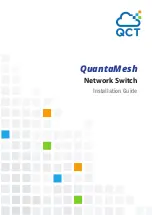
This class is created automatically when the system starts up (the class is named
class-default
in the
CLI). You cannot delete this class and you cannot change the match criteria associated with the default
class.
If congestion occurs when data traffic (class-default) and FCoE traffic (class-fcoe) is
flowing at the same time, then the queuing percentage configuration starts up.
The FCoE traffic is a no-drop class and does not get policed to the bandwidth assigned
as per the queuing class. FCoE traffic cannot be dropped as it expects a lossless medium.
When congestion occurs PFC frames are generated at FCoE ingress interfaces and
dropping only occurs on the data traffic, even if data traffic is below the assigned
bandwidth.
For optimizing the throughput you can spread the data traffic load for a longer duration.
Note
•
FCoE system class (For the Cisco Nexus 5500 Series device)
For the Cisco Nexus 5500 Series device, the class-fcoe is not automatically created. Before you enable
FCoE on the Cisco Nexus 5500 Series device running Cisco NX-OS Release 5.0(2)N1(1), you must
enable class-fcoe in the three types of qos policies:
◦
type qos policy maps
◦
type network-qos policy map (attached to system qos)
◦
type queuing policy map (class-fcoe must be configured with a non-zero bandwidth percentage
for input queuing policy maps.
When class-fcoe is not included in the qos policies, vFC interfaces do not come up and increased
drops occur.
The Cisco Nexus 5500 Series device supports five user-defined classes and one default
drop system class.
Note
MTU
The Cisco Nexus device is a Layer 2 switch, and it does not support packet fragmentation. A maximum
transmission unit (MTU) configuration mismatch between ingress and egress interfaces may result in packets
being truncated.
When configuring MTU, follow these guidelines:
•
MTU is specified per system class. The system class allows a different MTU for each class of traffic
but they must be consistent on all ports across the entire switch. You cannot configure MTU on the
interfaces.
•
Fibre Channel and FCoE payload MTU is 2158 bytes across the switch. As a result, the rxbufsize for
Fibre Channel interfaces is fixed at 2158 bytes. If the Cisco Nexus device receives an rxbufsize from a
peer that is different than 2158 bytes, it will fail the exchange of link parameters (ELP) negotiation and
not bring the link up.
Cisco Nexus 5000 NX-OS Quality of Service Configuration Guide, Release 5.1(3)N2(1)
36
OL-26657-01
Configuring QoS on the System
MTU
















































